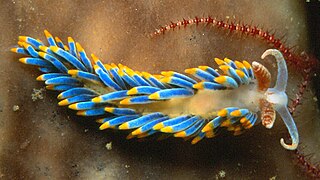
Nudibranchs are a group of soft-bodied, marine gastropod molluscs which shed their shells after their larval stage. They are noted for their often extraordinary colours and striking forms, and they have been given colourful nicknames to match, such as "clown," "marigold," "splendid," "dancer," "dragon," or "sea rabbit." Currently, about 3,000 valid species of nudibranchs are known.

Sea slug is a common name for some marine invertebrates with varying levels of resemblance to terrestrial slugs. Most creatures known as sea slugs are actually gastropods, i.e. they are sea snails that over evolutionary time have either completely lost their shells, or have seemingly lost their shells due to having a greatly reduced or internal shell. The name "sea slug" is most often applied to nudibranchs, as well as to a paraphyletic set of other marine gastropods without obvious shells.

Glaucus atlanticus is a species of small, blue sea slug, a pelagic aeolid nudibranch, a shell-less gastropod mollusk in the family Glaucidae.

The Chromodorididae, or chromodorids, are a taxonomic family of colourful, sea slugs; dorid nudibranchs, marine gastropod mollusks in the superfamily Doridoidea. “Chromodorid nudibranchs are among the most gorgeously coloured of all animals.” The over 360 described species are primarily found in tropical and subtropical waters, as members of coral reef communities, specifically associated with their sponge prey. The chromodorids are the most speciose family of opisthobranchs. They range in size from <10mm to over 30 cm, although most species are approximately 15–30 mm in size.

A rhinophore is one of a pair of chemosensory club-shaped, rod-shaped or ear-like structures which are the most prominent part of the external head anatomy in sea slugs, marine gastropod opisthobranch mollusks such as the nudibranchs (Nudibranchia), Sea Hares, (Aplysiomorpha) and sap-sucking sea slugs (Sacoglossa).
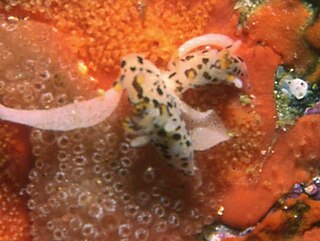
Goniodorididae are a taxonomic family of sea slugs, specifically dorid nudibranchs, marine gastropod molluscs in the order Opisthobranchia.
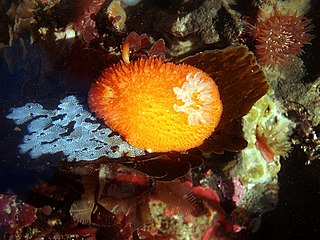
Acanthodoris lutea, the orange-peel doris, is a species of nudibranch or sea slug, a shell-less marine opisthobranch gastropod mollusk in the family Onchidorididae.

Ceratosoma amoenum, or the clown nudibranch, is a species of colorful dorid nudibranch, a sea slug, a shell-less marine gastropod mollusk in the family Chromodorididae.

Ancula is a genus of sea slugs, specifically dorid nudibranchs, marine gastropod molluscs in the family Goniodorididae.

The giraffe spot nudibranch, Ancula sp., as designated by Gosliner, 1987, is a species of colourful sea slug, specifically a dorid nudibranch, a marine gastropod mollusc in the family Goniodorididae. As of November 2009, it remained undescribed by science.
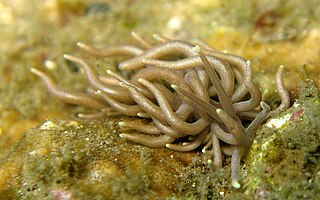
Phyllodesmium is a genus of predatory sea slugs, aeolid nudibranchs, marine gastropod molluscs in the family Facelinidae.

Hypselodoris kaname is a species of sea slug or dorid nudibranch, a marine gastropod mollusk in the family Chromodorididae.
Hypselodoris alboterminata is a species of sea slug or dorid nudibranch, a marine gastropod mollusk in the family Chromodorididae.
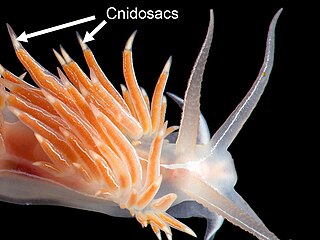
A cnidosac is an anatomical feature that is found in the group of sea slugs known as aeolid nudibranchs, a clade of marine opisthobranch gastropod molluscs. A cnidosac contains cnidocytes, stinging cells that are also known as cnidoblasts or nematocysts. These stinging cells are not made by the nudibranch, but by the species that it feeds upon. However, once the nudibranch is armed with these stinging cells, they are used in its own defense.
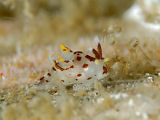
Ancula kariyana is a species of sea slug, a dorid nudibranch, a marine gastropod mollusc in the family Goniodorididae.

Ancula lentiginosa is a species of sea slug, a dorid nudibranch, a marine gastropod mollusc in the family Goniodorididae.
Ancula mapae is a species of sea slug, a dorid nudibranch, a marine gastropod mollusc in the family Goniodorididae.
Ancula espinosai is a species of sea slug, a dorid nudibranch, a marine gastropod mollusc in the family Goniodorididae.
Ancula evelinae is a species of sea slug, a dorid nudibranch, a marine gastropod mollusc in the family Goniodorididae.













